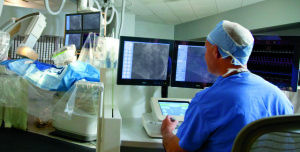by
Lauren Dubinsky, Senior Reporter | April 18, 2014

Corindus’ CorPath 200 System
From the April 2014 issue of HealthCare Business News magazine
New government incentives and technologies are molding the cath lab to adapt to the changing times.
The quest to cut costs is spurring more incentives to reduce the length of patient stays and interventional procedures are becoming less of an inpatient and more of an outpatient service. The incentives extend to integrating all hospital systems from a health information technology standpoint and cardiology systems are scrambling to play catch up.
New robotic systems and advanced imaging technology are also having an impact on the cath lab—making procedures easier and more efficient. DOTmed HealthCare Business News spoke with experts about these new incentives and technologies.



Ad Statistics
Times Displayed: 2147
Times Visited: 10 Fast-moving cardiac structures have a big impact on imaging. Fujifilm’s SCENARIA View premium performance CT brings solutions to address motion in Coronary CTA while delivering unique dose saving and workflow increasing benefits.
Get them home
“When CMS tells us that they’re not going to reimburse us if we keep the patients in overnight then it becomes pretty easy to decide how our priorities have to shift,” says Dr. Martin Leon, director of the Center for Interventional Vascular Therapy at NewYork-Presbyterian/Columbia University Medical Center.
Sending patients home same-day is not something new to cardiology. Dating back to the mid-1990s, cardiologists have been discharging low-risk patients the same day who undergo elective percutaneous coronary intervention procedures.
What’s changed now is that CMS is putting a greater emphasis on that shorter stay. For elective procedures, there is going to be a strong emphasis on the requirements to get patients in early and discharge them before the end of the day and eventually it will become the norm, says Leon.
The 2014 Medicare inpatient prospective payment rule included a new regulation called the two-midnight rule. It states that inpatient admissions that go beyond at least two midnights will receive Medicare Part A payments and inpatient stays that last fewer than two midnights must be billed as outpatient services.
Due to a lot of opposition this past year from hospitals and other health care organizations regarding confusion about the policy and the belief it challenges physicians’ medical judgment, CMS has delayed the rule until October.
Despite the resistance to the rule, sameday discharge may bring benefits to patients. “If you develop a proper triaging service and understand which patients you can safely send home, I don’t think that it’s any risk to the patient and frankly they wish to sleep in their own bed so I think there may be some advantages,” says Leon.
Connecting the dots
Cardiology departments today are entering into the same era that radiology departments entered in the mid-2000s. In today’s health care environment, the focus is on improving efficiency in patient care while reducing cost.

